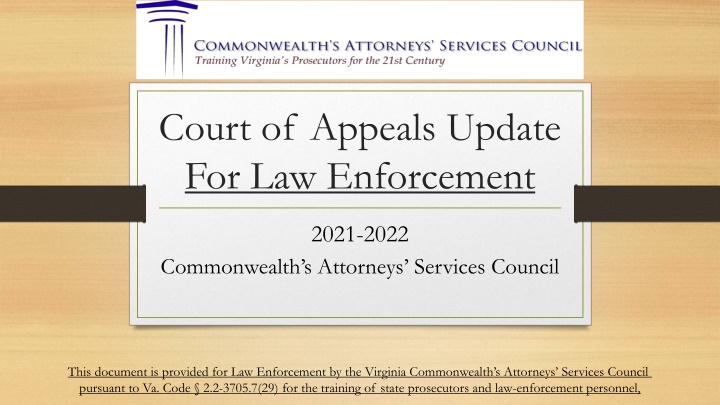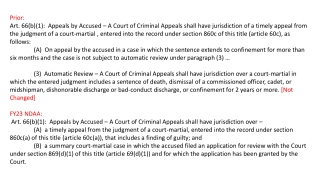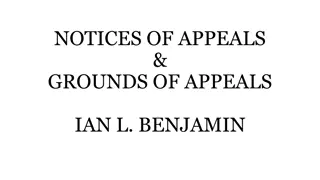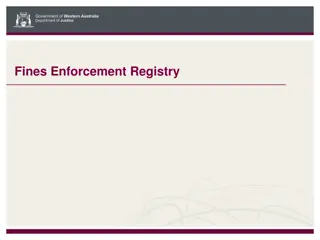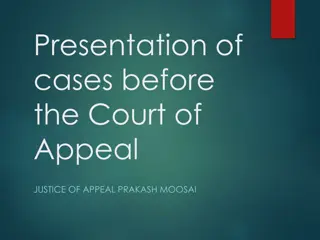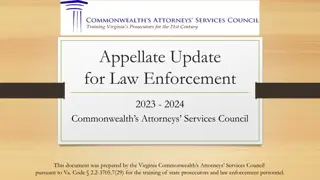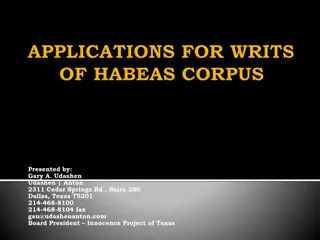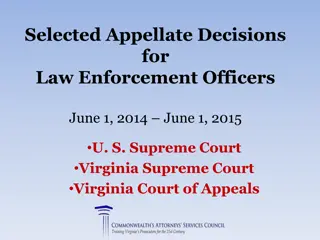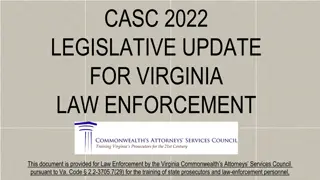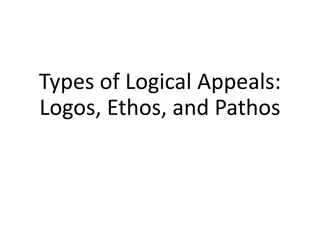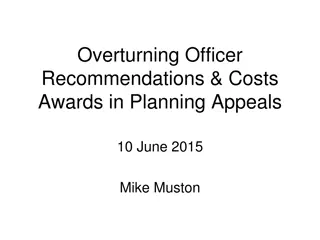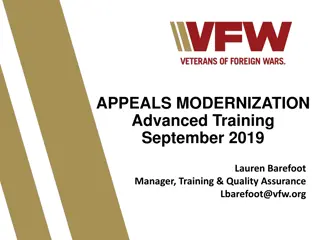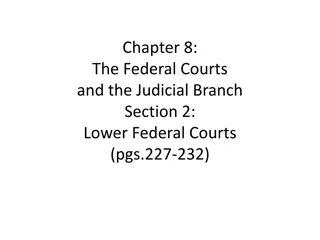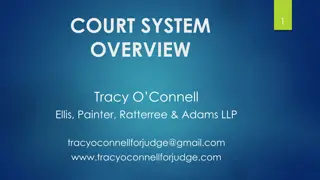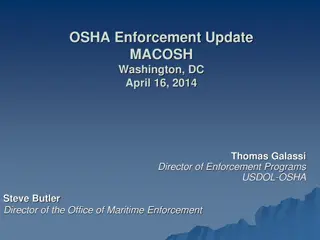Court of Appeals Update for Law Enforcement 2021-2022 Summary
This document provides an overview of significant changes, trends, and patterns in criminal procedure, constitutional law, and Virginia procedure as per the Court of Appeals Update for Law Enforcement 2021-2022 by the Virginia Commonwealth's Attorneys Services Council. It includes a case summary of Commonwealth v. Martinez ruling and highlights the importance of evidence suppression in cases of police misconduct. The presentation outlines the goals of covering changes, reviewing trends, and identifying future issues for law enforcement.
Download Presentation

Please find below an Image/Link to download the presentation.
The content on the website is provided AS IS for your information and personal use only. It may not be sold, licensed, or shared on other websites without obtaining consent from the author.If you encounter any issues during the download, it is possible that the publisher has removed the file from their server.
You are allowed to download the files provided on this website for personal or commercial use, subject to the condition that they are used lawfully. All files are the property of their respective owners.
The content on the website is provided AS IS for your information and personal use only. It may not be sold, licensed, or shared on other websites without obtaining consent from the author.
E N D
Presentation Transcript
Court of Appeals Update For Law Enforcement 2021-2022 Commonwealth s Attorneys Services Council This document is provided for Law Enforcement by the Virginia Commonwealth s Attorneys Services Council pursuant to Va. Code 2.2-3705.7(29) for the training of state prosecutors and law-enforcement personnel,
This Presentation is Only an OVERVIEW For a complete summary of all cases, including the facts and holdings, please see the full 2021 Case List in your Dropbox (192 pages) The mini-digest in your binder is only a summary. Both lists have cases broken down by topic and court, with citations when available at time of print.
Goals For Today 1)Cover Significant Changes and Holdings 2)Review Trends and Patterns 3)Identify Issues to Expect in the Future
PART ONE: Criminal Procedure Constitutional Law and Virginia Procedure
Fourth Amendment Search and Seizure
Commonwealth v. Martinez: Ct. App. May 24, 2022 (unpublished) Court ruled that the defendant s consent was involuntary. Court relied on the fact that three officers surrounded defendant, an officer took his license and did not return it, and no officer told him he was free to leave. Because the exclusionary rule is necessary to deter such police misconduct in the future, the Court affirmed the trial court s decision.
Court: Evidence Should be Suppressed The act of coercing consent while [the defendant] was awaiting medical assistance, and while the officers themselves were supposed to be aiding him, is police misconduct meriting the use of the exclusionary rule. It is objectively unreasonable for a police officer to not know that retaining a driver s license under the circumstances presented here constitutes a seizure of a suspect and that the consent following that seizure would be involuntary.
Lange, Hot Pursuit, and Homes One more time: Still only three ways into a home: Warrant, consent, or exigent circumstances
Lange v. California: No Hot Pursuit for DUI Defendant drew officer s attention by driving and playing music very loudly and repeatedly honking his horn. Officer signaled for defendant to stop, but defendant continued to drive up the driveway of his home and parked inside his garage. Officer followed the defendant into his garage, questioned him, conducted field sobriety tests, and arrested him for DUI. On appeal, California Court of Appeals ruled that hot pursuit into a home to prevent a suspect from frustrating an arrest is always permissible under the exigent- circumstances exception to the warrant requirement, even for a misdemeanor offense.
Supreme Court: Reversed In a 9-0 ruling, the Court held that the pursuit of a fleeing misdemeanor suspect does not always or categorically qualify as an exigent circumstance. While the Court agreed that a great many misdemeanor pursuits involve exigencies that would allow warrantless entry, the Court ruled that whether a given case does so turns on the particular facts of the case.
But Many Case Will Be Exigent Court agreed that on many occasions, officer will have good reason to enter to prevent imminent harms of violence, destruction of evidence, or escape from the home. But when the officer has time to get a warrant, he must do so even though the misdemeanant fled. Entry is not permitted with flight alone, without exigencies like the destruction of evidence, violence to others, or escape from the home. Lange v. California: 593 U.S. , 141 S. Ct. 1596 (2021)
Impact in Virginia: Six Recent Cases on Emergency Real-World Applications for Virginia LEOs
Emergency with Delay White v. Commonwealth Police responded to a call for a man who had reportedly beat a woman in the street with a gun. Police responded within minutes and found a large crowd gathered but did not find the victim or the defendant. Members of the crowd reported that a man had beaten a woman with a gun and that he had stomped on her head and then fled into a particular apartment.
Police Arrive at Apartment Police knocked on the apartment door and received no response. After police knocked on the door hard enough to shake the door, the victim came to the door carrying a child; she had a split lip that was swollen but not bleeding. Victim initially denied any altercation. Officers confronted her with witness statements, but the victim indicated that there had been a verbal argument only. While officers believed that it was possible that others could have been present in the apartment, they had received no information to suggest that anyone else was in the apartment.
Police Secure Victim Officers asked her if they could come inside to speak to her about it, but she said no and slid out of the apartment in such a manner that would not allow the officers or anyone else to see into the apartment. Victim then immediately shut the door behind her. She did not cooperate with the investigation, and instead was evasive and refused to identify the man who attacked her or to tell whether he was inside the apartment. Later, she provided a false name for the man.
Standoff To Entry Within 20 minutes of the first call to 911, twelve to fifteen officers were on the scene. Officers set up a perimeter, positioning some officers near the windows at the rear of the apartment. Officers decided to wait to enter the apartment until they could obtain a ballistic shield, approximately 6 miles away. Once the shield arrived, officers made a forcible entry. Forcible entry took place approximately 45 minutes after officers had first arrived on scene and approximately 30 minutes after the officers had persuaded the victim to leave the apartment.
Court: Evidence Suppressed absent other facts, such as sounds emanating from the dwelling indicating criminality, urgency, or exigency, the decision of a dwelling s occupants to stand on their constitutional prerogatives to refuse to answer the door or to refuse to allow police to enter once they have answered the door does not provide a basis for concluding exigent circumstances exist. After securing the victim, and the time from the initial parking lot altercation, the Court viewed the situation as less urgent when the officers entered without a warrant than when they first arrived.
Court: Defendant was a Threat, But. There was barely was even a theoretical possibility, let alone a likelihood that the defendant could escape if the officers had taken the time to get a warrant. Court noted that twelve to fifteen officers had formed a perimeter around the apartment, and the windows and the front door were the only means of ingress and egress from the third- floor apartment.
Court: Gun was a Threat, But the presence of a firearm, standing alone, is insufficient to establish exigent circumstances. Here, no shots had been fired that evening, the other participant in the altercation had been separated by both time and space from [the defendant], and [the defendant] made no threats to anyone, verbal or otherwise, after officers arrived on the scene.
Bottom Line: Nothing that officers observed or learned during the forty-five minutes on scene suggested that an imminent danger to life or public safety existed. By waiting 45 min before entering the apartment, Court found that officers conduct also suggested that there was not a compelling need for immediate official action because no such immediate action was taken. 45 min. delay, coupled with the ability of the officers to obtain a warrant relatively quickly without leaving the scene, meant the time necessary to obtain a warrant was not a significant impediment to the actions the officers wished to take and ultimately took. White v. Commonwealth: October 12, 2021 (Ct. App., Published)
Threat Man with Gun Walker v. Donahoe 4th Circuit A week after the Parkland school shooting, a citizen saw the defendant walking along the road, dressed in a black sleeveless shirt and camouflage pants, in a suburban neighborhood within a mile of a local school while carrying an AR-15-style rifle. Citizen called 911 and officers responded. Based on his appearance, officers believed that he could be under the age of 18. Officers detained the defendant, learned he was an adult who lawfully possessed the firearm, and a criminal history check revealed no ground for his continued detention. Officers released the defendant after than nine minutes.
Court: Lawsuit Dismissed Court ruled that the circumstances of defendant s firearm possession were unusual and alarming enough to engender reasonable suspicion. Although openly carrying a rifle is lawful in West Virginia, Court repeated that lawful conduct can contribute to reasonable suspicion. Possession of a firearm plus something more may justify an investigatory detention.
Courts Analysis Walker v. Donahoe: July 7, 2021 (4th Circuit) Court agreed that the officers had reasonable suspicion that the defendant was intent on perpetrating a mass shooting at the nearby school. Court pointed out that the defendant was in dressed to look like a soldier, and carrying a type of rifle that has been the weapon of choice for the deadliest mass shooters of the past decade, one that had just been used at Parkland school shooting one week before. Court also noted that the fact that the defendant was walking rather than driving suggested that he might be a minor and perhaps a student at the nearby school.
Threat Man with Crossbow U.S. v. Coleman SRO responded to a high school administrator s report that, as students were arriving that morning, an unknown man (who was plainly a non-student) was parked erratically in the campus parking lot, asleep or passed out in his vehicle with a crossbow visible in the backseat. Concerned for safety and believing that possession of the crossbow was illegal under 18.2-308.1, officer pulled behind defendant s vehicle. Defendant s vehicle was running, had its brake lights engaged, and was haphazardly positioned and impeding a travel lane. When officer opened the door of his police cruiser, defendant began to drive away, and officer then engaged his emergency lights, stopping defendant.
Court: RAS for Stop Court: Presence of an unidentified individual on a school campus is a valid safety concern. Court: Reasonable officer could suspect that defendant was trespassing on school grounds, in violation of the school board policy and 18.2-128(b). Court: Reasonable officer could determine that defendant was committing a parking violation. Court: Reasonable officer could suspect that defendant was unlawfully operating his vehicle under the influence, as he remained asleep or passed out during the bustling morning hours at the school.
Role of Crossbow Reasonable officer could conclude that, though it may have been lawful, defendant was in possession of a dangerous weapon on school grounds, which could be used to harm students, faculty, and/or staff at the school. Legality of crossbow possession under Virginia law was largely tangential to the question of whether the officer s suspicion was reasonable. Reasonable minds could differ on whether 18.2-308(A) encompasses crossbows, since crossbows bear resemblance to slingshots, which are enumerated in the statute.
Court: Quotes Aguilera ruling in Ca. [S]chool officials, when faced with the credible threat of [weapon] violence, must have flexibility to respond in the manner most appropriate to protect the lives of students. Indeed, would any reasonable parent . . . send her child to [school] if a suspected armed non-student could not be disarmed by school administrators? It simply defies common sense to tie the[ir] hands . . . when they reasonably suspect a non-student visitor, armed with a weapon, threatens the lives and safety of students.
Emergency & CLSI Homicide Moreno v. Commonwealth Defendant, angry at his sister, struck her with his car and killed her. Witness tried to stop him, but defendant disregarded and continued driving. Witnesses later identified defendant s vehicle and photograph to police. Officer drove to defendant s residence but did not find him. Officer called and texted defendant s phone but got no response. Officer obtained the real-time Cell-site location data (CSLI) data for defendant s cell phone and located him and his car
Court: Proper Due to Emergency Moreno v. Commonwealth: 73 Va. App. 267, 858 S.E.2d 432 (2021) Warrantless request for real-time CSLI data to locate a fleeing murder suspect in an exigent circumstance is permissible under Carpenter. When law enforcement obtained the CSLI data, they needed to pursue what reasonably appeared to be a fleeing murder suspect. Defendant had possession and control of a significant piece of evidence the vehicle and every minute that passed afforded the defendant the opportunity to hide or destroy that evidence and evade apprehension.
Emergency & CLSI Armed & Dangerous U.S. v. Hobbs Defendant, convicted felon, broke into woman s home and committed an assault and a theft inside. Defendant threatened her life with a handgun and said he would not be taken alive by police. Defendant owned a rifle as well and was obsessed with firearms. Officers also knew that the defendant had a criminal history of violent offenses, including convictions for robbery and attempted murder.
Ping of Defendants Phone After assessing that victim s account was credible and observing damage to her home, police requested defendant s location data from T-Mobile without a warrant, contending that the situation was an exigent circumstance. Within an hour, T-Mobile responded with real-time pings on defendant s cell phone that alerted police to every 15 minutes to defendant s general location. Police used T- Mobile call logs to determine defendant s location more precisely. Officers located defendant, arrested him, and recovered his firearm.
Court: Search Lawful Court: Officers reasonably concluded that use of the exigent form was necessary to obtain a prompt response from the cell phone provider when an armed and dangerous suspect was at large. In this case, the only way to get help from T-Mobile in a timely fashion was by submitting an exigent form. Court: Officers reasonably concluded that defendant was armed and dangerous, that he posed an imminent threat to the victim, to her family members, and to law enforcement officers, and that these exigent circumstances required them to seek the cell phone location information from T-Mobile without delay.
Pure Emergency Fourth Amendment Post-Caniglia What are the rules when life is at stake?
Rescue Overdose McCarty v. Commonwealth: November 9, 2021 Defendant overdosed in a hotel room. Anonymous person called 911 and police responded to the room. Finding the door slightly ajar, they saw the defendant on the floor, near the bed. Defendant was unconscious, pale in the face, cool to the touch, sweating profusely, and struggling to breathe. Officers believed the defendant was suffering from an overdose.
Hotel Search As medics attempted to revive the defendant without success, officers first conducted a cursory sweep of the motel room to see what they could find in plain view. Officers then opened the nightstand s drawer and discovered a clear baggie containing heroin. Officers informed the medics of the substance. Medics revived defendant a few minutes later, and when asked by medics what substance he took, he admitted he had snorted heroin.
Was the Search Ok under Caniglia? Because Caniglia made clear that the community caretaker exception does not apply to warrantless searches of the home, the Court held that the exception does not apply to motel rooms either. Consequently, the Court determined that the trial court erred in relying on the community caretaker doctrine to deem the officers search of the defendant s motel room lawful.
BUT Search Still Ok as Exigent Circumstance. Court: The emergency aid doctrine gives law enforcement some leeway to search areas beyond what is in plain view and that the officers search here was within the scope of that leeway. it very likely would have been irresponsible for the officers not to have searched the nightstand when considering that appellant s life was still in danger and EMS personnel had not identified the cause of appellant s circumstances It would be an affront to that commonsense rationale to hold that the Fourth Amendment required the officers to throw up their hands and call it quits once the initial cursory survey provided no clues as to appellant s medical condition.
Rodriguez and Extending Traffic Stops Scope of Lawful Detention
Basic Legal Standard If you have Reasonable Suspicion that an individual is engaging in criminal activity: You may detain a person for a reasonable amount of time in order to Identify suspect Question them briefly Confirm or dispel your suspicions You may use whatever force or steps as are necessary to maintain the status quo.
Reasonable Amount Time Is If an officer can complete traffic-based inquiries expeditiously, then that is the amount of time reasonably required to complete the stop s mission OL, Registration, Insurance, Record and Wanted Checks Are Routinely Permissible A traffic stop prolonged beyond that is unlawful. "On-scene investigation into other crimes detours from that mission Rodriguez v. United States, 575 U.S. 348, 354 (2015).
U.S. v. Buzzard, et. al. June 11, 2021 1 F.4th 198 (2021) One night, an officer observed car commit a traffic violation and stopped the vehicle. The area was a high-crime area, where officers, including this officer, had previously made multiple arrests for narcotics. Officer had prior interactions with one of the defendants while on duty, noting that he had a history of drug addiction, had recently gotten out of prison, and was a convicted felon. Officer requested that backup officers join him.
Investigation While waiting, the officer observed that one defendant was moving around and not making eye contact in an unusual way. He asked the defendants whether there was anything illegal in the car. They replied that they had drug paraphernalia. Other officers responded and patted down the defendants. One of the defendants then revealed that there were guns in the car. Defendant and his compatriot were felons
Court: Search Lawful Court found that the question Is there anything illegal in the vehicle? related to officer safety and thus related to the traffic stop s mission. Court noted that the officer was outnumbered, and he asked the question because of the time of night and the high drug area, the one occupant s criminal history, and the occupant s behavior. Given the totality of the circumstances, it makes sense that he needed to know more about what [they] had in the car.
Question WAS Problematic Court acknowledged that the question Is there anything illegal in the vehicle? could be interpreted more broadly than one worded slightly differently (for example, Is there anything dangerous in the vehicle? or Are there weapons in the vehicle? ). However, the Court explained that because traffic stops are especially fraught with danger to police officers, we decline to require such laser-like precision from an officer asking a single question in these circumstances.
Did NOT Unlawfully Extend the Stop Court also pointed out that officer s question didn t extend the stop by even a second. Court noted that, at the time, officer did not yet have the information he needed to perform the customary checks on the driver and vehicle and was waiting for an additional officer to arrive so he could safely proceed with the stop. Because he asked the question during a lawful traffic stop and the question did not prolong the stop, Court found that officer s question was proper under Rodriguez, even if it exceeded the scope of the stop s mission.
U.S. v. McNeil: 4th Circuit January 13, 2022 Officers stopped car for speeding and expired registration. Officer completed his speeding investigation in approximately 11 minutes. During this time, the officers questioned the defendant and his companion about their personal backgrounds and travel plans without prolonging the stop.
Observations Officers made several observations that caused them to extend the stop and request a drug-detection K9: Occupants conflicting stories regarding the length of their visit to New Jersey and how long they had known each other, Defendant was breathing heavily, his carotid artery pulsating, and continuing to stare at his phone when approached by the officer, which was abnormal and appeared evasive.
Observations (cond) Officers also pointed to the occupant s increasing nervousness, including his hand shaking when providing his license and beginning to sweat when the officer asked for consent to search the car, pinpoint pupils, and fresh track marks on both arms, indicating recent drug use. Officers also noted the men s known involvement in narcotics trafficking that was the subject of an ongoing investigation, and the defendant s criminal history involving drugs.
Officers Find Drugs A K9 unit arrived and detected drugs in the car. Officers found heroin District court denied the defendant s motion to suppress.
Court: Stop and Search Lawful Court: Officers had reasonable suspicion to extend the traffic stop for a dog sniff. Court observed that the initial investigation was reasonably related to the speeding and registration violations. Court repeated that, Rodriguez, an officer may permissibly ask questions of the vehicle s occupants that are unrelated to the alleged traffic violations, provided the conversation does not prolong the detention. Court: Officers provided articulable reasons justifying their reasonable suspicion to prolong the stop.
